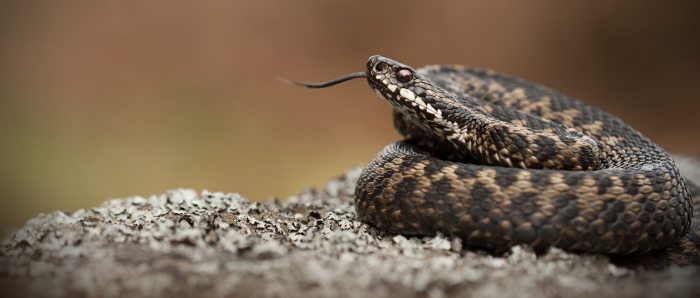WARNING: ADDER BITES NOW COMMON IN OUR AREA!!

A European Adder (Vipera berus).
Basking on a lichen covered rock and tasting the air with its’ tongue.
WARNING: ADDER BITES NOW COMMON IN OUR AREA!!
6 Bites at New Miller Dam in last couple of weeks.
What to Do if an Adder Bites Your Dog
I would imagine that quite few of my readers are starting to notice a trend in my previous blogs, in that they relate a lot to the weather conditions. The reason for this is that the seasons can have an adverse effect on the health of our animals, whether directly (e.g. due to temperature) or indirectly (e.g. because of insects).
But what else should owners and vets be aware of that may cause serious harm to our loved ones? How about the United Kingdom reptile population? As a reptile owner, this is something that I am very aware of, but not all owners are.
Yes, many of us have had the pleasure of catching frogs, toads, newts and slow worms, and asking your parents to build a pond or to keep them in your bedroom. Not just me! What about another reptile though?
What about the Adder?
The Adder is a venomous snake that is native to the UK. Adult snakes, once fully grown, have a length of around 50-60cm long. Most adders are distinctively marked with a dark zigzag running down the length of the spine, with an inverted V shape on the next.
Males are generally white or pale grey with a black zigzag, whereas females are a pale brown colour with a darker brown zigzag.
Adders are relatively common in areas of rough, open countryside and are often associated with woodland edge habitats. They emerge from their hibernation location around early spring and are more active on warmer days and can usually be spotted basking in the sun.
If you spot an adder, just back away and try not to startle it. Most adders, if not all, will only bite as a defence strategy, and not out of aggression.
How to tell if an Adder bites your dog
If you are walking with your dog and he or she gets bitten, you will normally be alerted by a yelp or a whimper. You might think that it’s just attention seeking or a thorn, but you should always carry out an examination if your dog seems distressed.
Adder bites result in local swelling which is often dark in colour, due to the reaction to the venom. There may be two visible punctures at the site of the bite, where the upper fangs have penetrated the skin of your animal. Dogs commonly get bitten on the legs, as they walk past the adder, or on the face, as they use their nose to investigate this strange object they have stumbled upon.
Clinical signs include:
- Pale mucous membranes
- Bruising to the area
- Salivation
- Vomiting
- Breathing difficulties
- Shivers and convulsions
- Collapse (only occasionally)
What to do if an Adder bites your dog
- If you suspect that your dog has been bitten by an adder seek veterinary treatment immediately
- Don’t allow your dog to walk, as this will circulate the venom around the body faster
- Bathe the wound in cold water to help treat the swelling
- Keep as quiet as possible whilst being transported
Treatment
Treatment will include:
- Pain relief
- Treatment for swelling and possible shock, often in the form of IV fluids
- Anti-venom is recommended.
